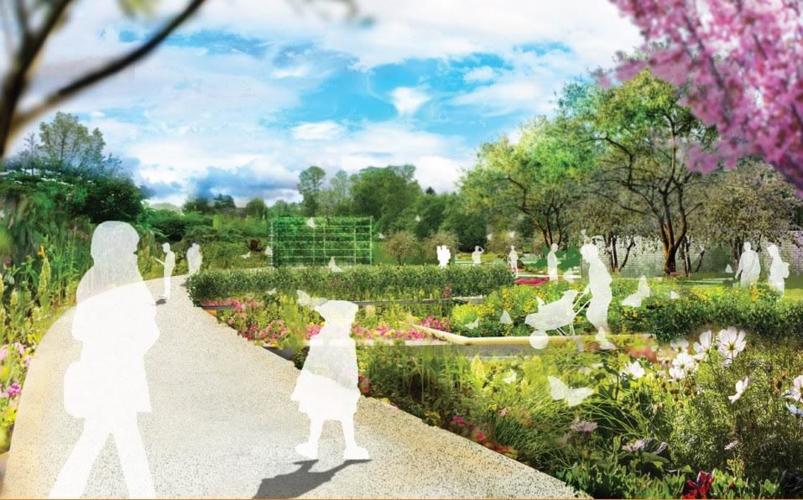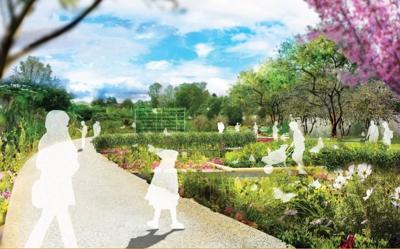After years of planning and research by Penn State’s Center for Pollinator Research, a large pollinator garden is set to break ground at the Arboretum in the fall 2019.
The Arboretum became home to a pollinator garden nearly a decade ago, which is currently still in place. However, many found it to be small and lacking diversity. Kim Steiner, the director of the Arboretum, said he began thinking about creating a bigger pollinator garden shortly after the first was created.
Steiner said they were “planning something that would be different from any other pollinator garden ever built.” He described most pollinator gardens across the country as being “superficial” by creating the “illusion” of a good pollinator garden by only attracting butterflies.
Harland Patch, an entomologist with the Center for Pollinator Research, believes knowledge on pollinator gardens need to be more widely available.
“Our goal was simple,” Patch said via email. “To build a better pollinators' garden that supported the broadest biodiversity possible and communicated the principles, including the plant lists, to the broad public.”
The pollinator garden is projected to be completed by the summer of 2020, meaning that it will be available for students at the beginning of the 2020-2021 school year. It will sit between the Children’s Garden and the Schreyer House.
Shari Edelson, the director of horticulture and curator at the Arboretum, said that many people believe the gardens are merely somewhere to look at flowers. However, Edelson believes education on pollinators is important because “over 80% of flowering plants rely on pollinators to reproduce.”
The upcoming pollinator garden has gone through several conceptual plans and designs in order to be as effective as possible. Currently, the final designs are being created and are expected to be completed in the upcoming weeks.
The Children’s Garden is one of the most popular destinations at the Arboretum. Steiner noted that it actually attracts more adults than children because of the designs that make it “appealing” for people of all ages. He said they chose to hire the same designer for the pollinator garden in order to make it “almost as interesting to go through as the Children’s Garden.”

The current plan of the pollinator garden which will sit between the Schreyer House and the Children's Garden.
Patch said the pollinator garden will act as a “series” of smaller gardens. The overarching gardens will include a bird garden and a pollinator’s garden, which were initially separate though eventually merged together in the planning process.
Throughout the area, there will be a food garden and floral garden to educate on the importance of pollinators in the food system as well as the different floral structures pollinators use. Patch added that there will also be a research garden that will showcase “important historical research in pollination science and even ongoing projects for current students and faculty” at Penn State.
Edelson believes that many features of the garden, including a meadow disk, orchard area and boardwalk, will be “visually striking.” There will be a bird observation deck where faculty and students can see different species of birds as they bathe, feed and potentially nest. The garden will also include an entry gate, which was chosen as the Class of 2019 gift and which Edelson said she was very “excited” for.
The landscape of the garden has been designed in order to benefit the different pollinators of the region. Different landforms will be included throughout the garden along with several different ecosystems. Patch said there will be a forest area and a wetland area for different types of pollinating plants.
“Some of the things we’re trying to achieve in this garden have never been done before,” Edelson said.
She added there are designs in the work for an observation hive where visitors can “view a honeybee colony at work.”
There is vast potential for the pollinator garden to bring something new to the Arboretum. Steiner believes it “adds a different dimension” because most of what is currently in place is “decorative.” He said that the added feature to the Arboretum will bring a “scientific component.”
Steiner said the garden “embodies a big issue people are aware of,” though many people focus merely on honey bees and butterflies when they think of pollinators. However, there are many species of pollinators native to Pennsylvania ranging from bees and butterflies to beetles and flies. Steiner believes they are “just as important,” and hopes that the pollinator garden will “be at the forefront of education” on these different species.
Those working on the project have high hopes for its ability to enrich the student experience while on campus. It has the chance to reach students in all fields of education, as well as provide the opportunity to explore the natural wildlife of Pennsylvania.
“We want this garden to function on multiple levels,” Patch said. “It should be simply a beautiful place students can go to submerge themselves in the living dynamic world- far away from their screens.”
Steiner hopes the garden will continue to engage the public for many years to come, even after team members move on.
“You can’t count on [faculty] forever, but I plan on having that pollinator garden forever,” he said.






